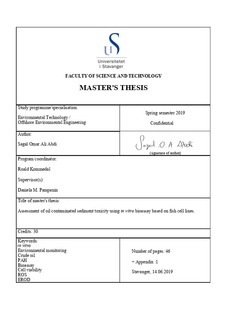| dc.contributor.advisor | Pampanin, Daniela.M | |
| dc.contributor.author | Abdi, Sagal Omar Ali | |
| dc.date.accessioned | 2019-10-22T06:40:51Z | |
| dc.date.available | 2019-10-22T06:40:51Z | |
| dc.date.issued | 2019-06-14 | |
| dc.identifier.uri | http://hdl.handle.net/11250/2623594 | |
| dc.description | Master's thesis in Environmental technology | nb_NO |
| dc.description.abstract | A series of oil-contaminated sediment samples (drill cuttings) have been analyzed for their toxicity using in vitro bioassay based on fish cell lines. Drill cuttings are pieces of rock that come out of a well, (a deep hole made in the ground, to locate oil) when a well is drilled to an oil or gas reservoir. During drilling operations, a fluid known as drilling mud is used to lubricate the drill bit and carry the drill cuttings to the surface, where they are separated from the mud and cleaned. The mud is reused where possible, and the drill cuttings are either discharged or taken ashore for further treatment and disposal. Unfortunately, up until the mid-1990s, discharge of cuttings to the seabed was permitted in most countries. Therefore, they have formed piles on the seabed and also settled on and between some of the oil storage cells. The evaluation of the toxicity of the drill cuttings and in particular their potential adverse effects in marine organisms is of known importance. The present work focuses on the use of in vitro cell based bioassay to evaluate the ecotoxicity of drill cuttings. By using fish cell line (i.e., PLHC-1 and RTgill-W1), the quality of these sediment types were assessed through assays for general cytotoxicity, reactive oxygen species production (i.e., oxidative stress) and EROD activity (a PAH related metabolism enzyme). The obtained results were compared with data from natural fjord sediment samples. The cell viability, EROD activity, and ROS production showed an adverse effect to the oil-contaminated drill cutting for PLHC-1 in comparison to the natural fjord sediments. While RTgill-W1 showed an adverse effect in cell viability and ROS production for oil-contaminated drill cuttings in contrast to the natural fjord sediments. | nb_NO |
| dc.language.iso | eng | nb_NO |
| dc.publisher | University of Stavanger, Norway | nb_NO |
| dc.relation.ispartofseries | Masteroppgave/UIS-TN-IKBM/2019; | |
| dc.subject | teknisk miljøvern | nb_NO |
| dc.subject | miljøteknologi | nb_NO |
| dc.subject | offshore teknologi | nb_NO |
| dc.subject | environmental engineering | nb_NO |
| dc.subject | offshore technology | nb_NO |
| dc.subject | råolje | nb_NO |
| dc.title | Assessment of oil contaminated sediment toxicity using in vitro bioassay based on fish cell lines. | nb_NO |
| dc.type | Master thesis | nb_NO |
| dc.subject.nsi | VDP::Technology: 500::Environmental engineering: 610 | nb_NO |
| dc.subject.nsi | VDP::Technology: 500::Marine technology: 580::Offshore technology: 581 | nb_NO |
